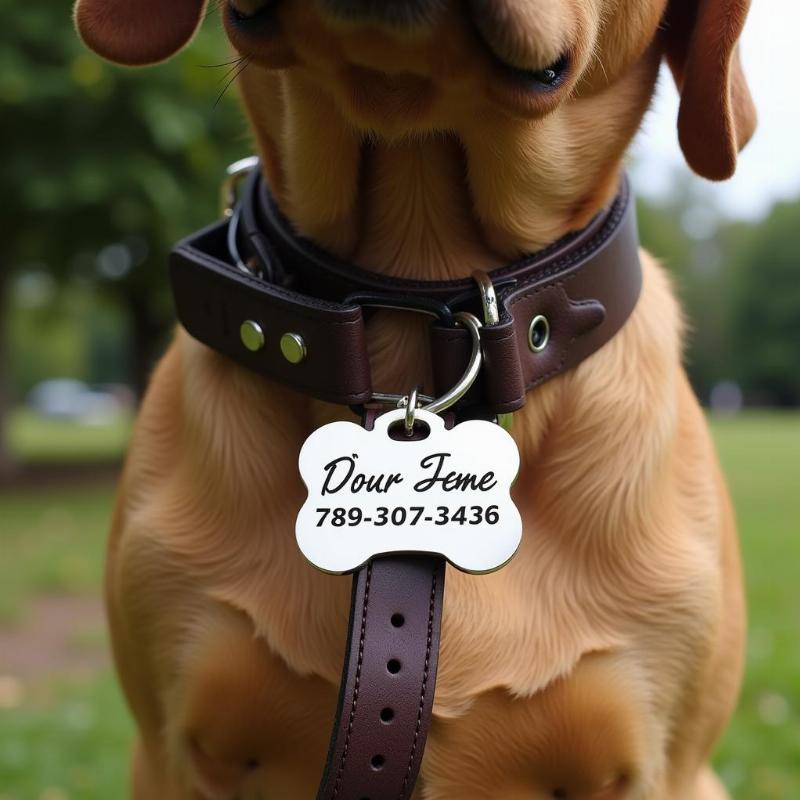A dog tag securely attached to your dog’s collar is more than just a stylish accessory; it’s a vital piece of identification that can reunite you with your furry friend if they ever get lost. In the US, where millions of dogs become lost each year, a dog tag attached to collar is your pet’s ticket home. This guide will explore the importance of dog tags, the best ways to attach them to your dog’s collar, and what information to include.
Why a Dog Tag Attached to Collar is Essential
Microchipping is a fantastic tool for pet identification, but it requires a scanner and a vet or shelter to access the information. A clearly visible dog tag attached to collar provides immediate identification, allowing anyone who finds your dog to contact you directly. This saves valuable time and can be the difference between a quick reunion and days of worry. This is especially crucial in situations where your dog may be injured and unable to be scanned immediately.
 Dog Tag Attached to Collar Close Up
Dog Tag Attached to Collar Close Up
Choosing the Right Dog Tag and Attachment
Dog tags come in various shapes, sizes, and materials. Stainless steel is a popular choice due to its durability and resistance to rust. Consider the size and breed of your dog when selecting a tag. A large, heavy tag can be cumbersome for a small dog, while a tiny tag might get lost on a larger breed.
For attaching the tag to the collar, split rings are the most common and readily available option. Ensure the split ring is closed securely to prevent the tag from falling off. Some collars have dedicated tag loops, providing a more secure attachment point. You can also consider dog collar with attached tag.
What Information to Include on Your Dog’s Tag
The information engraved on your dog’s tag should be concise and easy to read. At a minimum, include your dog’s name and your phone number. Including your city and state can be helpful, especially if you live near state lines. While including your address is optional, some owners prefer to provide this information.
Attaching the Dog Tag: Best Practices
Ensure the tag hangs freely and doesn’t get caught on anything. Avoid attaching too many tags to the collar, as this can be noisy and uncomfortable for your dog. Check the tag and its attachment regularly for wear and tear. Replace the tag if it becomes worn or the information is no longer legible. For a safer and more convenient option, consider a bring them home dog tag.
Ensuring Your Dog’s Tag Stays Put
A dangling dog tag can sometimes get caught on branches or fences. While rare, this can be dangerous. Consider using a tag silencer, a small rubber ring that fits around the edge of the tag, to minimize noise and prevent snagging. Regularly inspect the collar and tag to ensure they are in good condition and securely fastened. A sturdy, well-maintained spiked studded leather dog collar can also provide a secure base for the tag.
Conclusion
A dog tag attached to collar is a simple yet essential element of responsible pet ownership in the US. By following these guidelines and choosing a durable tag with clear information, you can significantly increase the chances of a swift and happy reunion should your beloved companion ever wander off. Don’t delay, ensure your dog’s tag is up-to-date and securely attached today.
FAQ
- Do I need a dog tag if my dog is microchipped? Yes, a dog tag provides immediate identification, while a microchip requires a scanner.
- What is the best material for a dog tag? Stainless steel is durable and resists rust, making it a popular choice.
- How much information should I put on the tag? Include your dog’s name and your phone number at minimum. City, state, and address are optional.
- How can I prevent the tag from getting caught? Use a tag silencer or ensure the tag hangs freely on the collar.
- How often should I replace my dog’s tag? Replace it when it becomes worn or the information is no longer legible.
- Can I personalize my dog’s tag? Yes, you can find tags in various shapes, sizes, and with options for personalized engraving. Consider looking at dog tag blanks for laser engraving.
- What if my dog doesn’t like wearing a collar? Gradually acclimate your dog to wearing a collar for short periods, using positive reinforcement.
Beautdogs.us is your premier online destination for all things dog-related in the US. We offer expert advice on dog breeds, care, and products, empowering pet owners to provide the best possible care for their furry friends. Whether you’re a seasoned dog owner or just starting your journey, Beautdogs.us has the resources you need. Contact us today for personalized support! Email: [email protected], Phone: +1 501-555-7529.